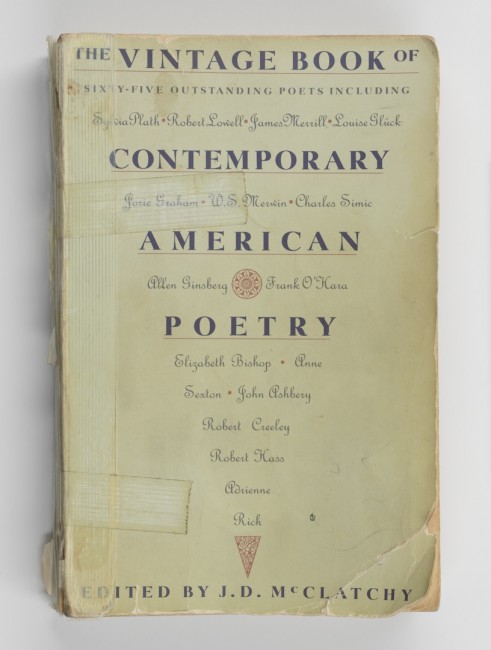Tanning's Anthology
J. D. McClatchy
2015
© J. D. McClatchy
This tribute was written to accompany the exhibition "Dorothea Tanning: Murmurs" at Marianne Boesky Gallery, New York, in collaboration with Alison Jacques Gallery, London, May 11 - June 27, 2015 (view a gallery of images from the show here).
In 1990 I gave Dorothea a copy of an anthology I had edited, The Vintage Book of Contemporary Poetry, just then published. Of course, she had been reading poetry for decades—but mostly the old masters. And of course, some of her friends were among the distinguished poets of the day—James Merrill, Richard Howard, Rosanna Warren, and others. But sitting down to the 65 poets gathered in the book was her introduction to many new voices, and may well have spurred her to spend more time composing her own poems.
In 1990 I gave Dorothea a copy of an anthology I had edited, The Vintage Book of Contemporary Poetry, just then published. Of course, she had been reading poetry for decades—but mostly the old masters. And of course, some of her friends were among the distinguished poets of the day—James Merrill, Richard Howard, Rosanna Warren, and others. But sitting down to the 65 poets gathered in the book was her introduction to many new voices, and may well have spurred her to spend more time composing her own poems.
It is fascinating today to page through the book—the battered, torn, taped-together, dog-eared book! Could anyone have read it more attentively than she? Everywhere are her comments in pencil. For instance, she addresses me when she disagrees with a point in my introduction to the book; up the margin she’s written “I wish you hadn’t said that, Sandy.” To the table of contents she added names of poets she wanted to have been included. Poems she is especially fond of have a star drawn above them. There will be an emphatic “YES” beside a passage she admired, or sometimes “lovely” or “sweet”—even the less complimentary “cute.” A strongly feminist poem by Carolyn Kizer has “awful” next to it. A Charles Wright poem has “nuggets of joy” written under it. A poem by Louise Glück has an ecstatic “Oh!” above it and star-like lines circling the whole text. She constantly underlined words or phrases that struck her. On a couple of poems she playfully scratches out a “his” and substitutes a “her.” She has scanned one poem and in a villanelle has connected all the rhyming lines, making the poem look like a birdcage.
What strikes me after all this time is her openness to the challenges of individual poems—their complexities and mysteries, what they withhold and freely give. It reminds me of Dorothea in conversation—curious, sometime querulous, always intent on a friend’s mind and heart, on their implications and overtones. And the way she read--and wrote!—poems strongly recalls her art. In both, she is compelled by technique and enmeshed in astonishment. As critic John Russell once wrote of her paintings, “seen through the prism of the entire oeuvre one recognizes a blueprint for a totally personal view of the world, a proposal, as remarkable for its daring as for its difference, to bring the other, interior world to view.” Isn’t that what the best poets do as well? With lines like brushstrokes, the poet wants to blend the colors of the world, wants to startle, to recover, to renew. Dorothea Tanning understood that instinctively, and in the poems she studied so carefully she sensed a natural affinity. She reads a poem, yes. But she is also looking at it, studying its gestures and effects. And when she draws or paints, she is reading her own imagination, tracing its impulses and figures.
The result is extraordinary. Few painters have been such ardent readers as Dorothea Tanning was. Fewer still such fine poets. The way she combined her gifts is unparalleled.


